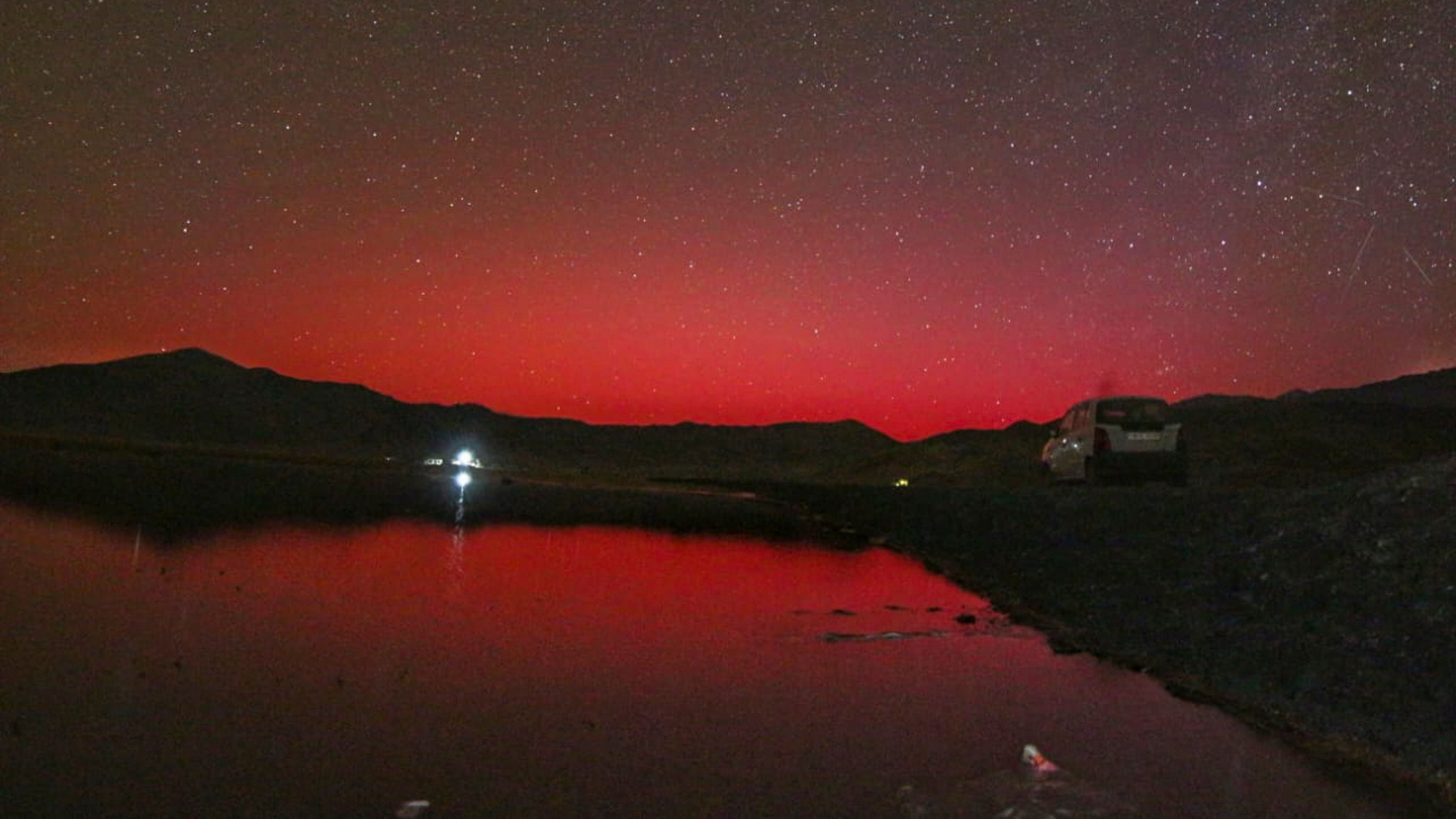
The appearance of intense red-coloured light rays in the sky on the intervening night of October 10-11 was the latest in a series of recent auroral sightings.
Credit: PTI Photo/Stanzin Norlha, Wangchuk Namgyal and Stanzin Norboo
New Delhi: Ladakh's recent sightings of aurora, marked by reddish or greenish light in the night sky and usually observed in the far northern regions, is a validation of our efforts in space weather monitoring, a team of astrophysicists that predicted the activity about 48-72 hours prior said.
The appearance of intense red-coloured light rays in the sky on the intervening night of October 10-11 was the latest in a series of recent auroral sightings -- previous ones occurred on those of May 11 this year, and November 5 and May 10 of 2023.
All-sky cameras of the Bengaluru-based Indian Institute of Astrophysics (IIA) at Hanle and Merak in Ladakh captured the aurorae throughout the night.
Dibyendu Nandi, head of the Center of Excellence in Space Sciences India (CESSI) at the Indian Institutes of Science Education and Research (IISER) Kolkata, told PTI, "The aurora sightings are a validation that we are on the right track. It boosts our confidence to predict extreme weather events in space that can potentially endanger all kinds of satellite-based services on Earth, bringing modern society to a standstill."
Space agencies and organisations such as National Oceanic and Atmospheric Administration (NOAA), US, monitor space weather to provide timely information of disruptions from the Sun, that can possibly cause communication blackouts and satellite outages.
While aurorae are known for their scenic beauty, their occurrence in lower-latitude regions like Ladakh is an indication of heightened solar activity in the form of solar storms known as coronal mass ejections, or CMEs., Nandi said. Solar storms periodically occur as the Sun's internal dynamo process -- that creates its magnectic field -- intensifies and weakens.
This cycle of solar activity typically lasts 11 years. In 2018, CESSI team which included Nandi as a member, predicted that the current solar activity cycle would peak in 2024, a finding published in the journal Nature Communications.
"However, we continue to track solar activity to determine if the current cycle has indeed peaked," Nandi said.
An aurora occurs when charged particles from the Sun interact with the Earth's magnetosphere or magnetic field, which acts as a shield against harmful solar and cosmic rays. These particles pierce through the shield, triggering aurorae.
The phenomenon is most commonly seen in the far northern regions of Canada, Norway, Sweden, Finland, Alaska and Russia, and all of Iceland and Greenland.
However, the recent aurorae were also witnessed in the low-latitude regions of Mexico and Germany, Nandi added.
"The current Solar Cycle 25 is at its peak levels of sunspot activity, which is significantly higher than the previous Cycle 24," said IIA Professor S. P. K. Rajaguru.
The current solar cycle is said to have begun in December 2019, with the preceding one said to have begun from December 2008.
On October 7, Nandi's team at CESSI was alerted to a possibly adverse development in space weather, when they saw multiple "active" regions in the Sun's magnetic field facing the Earth.
"Some filaments (sheared magnetic field structures in the lower solar atmosphere) are also observed on the Earth-facing solar disk. There are chances of flare or filament eruption induced coronal mass ejections. Current near-Earth space weather conditions are moderately perturbed," CESSI had said in a post on X on October 7.
"This is when our machine learning based computer models first flagged the possibility of solar flares and associated solar storms. When the storm indeed took off, we analysed its satellite observations and predicted a 'severe' (solar) storm on October 9," Nandi said.
The astrophysicist explained that a 'severe' solar storm is capable of triggering aurorae and enhancing orbital decay of satellites, while an 'extreme' one is capable of "killing satellites, tripping power grids and causing large-scale communication blackouts".
The team detected two solar storms directed at Earth, because of which they expected a "further escalation in space weather conditions over the next 24-36 hours", according to their post on X on October 9.
"For an extraordinary fourth time during the current solar cycle, intense red coloured auroral activity was seen from Ladakh, India, and was photographed by astronomers of the Indian Institute of Astrophysics (IIA) from Hanle, Leh, and Merak on the night of 10-11 October 2024," the institute's press statement read.
Easily seen with the "unaided eye", bright red streamers forming the aurora started to appear by 10:45 pm and continued to be intense till dawn, it said.
Nandi said that the aurora sightings "herald the peak of the current solar cycle".
However, whether or not the current cycle has peaked will need to be watched out for. This would possibly be marked by less frequent solar storms and aurorae over the years when the Sun's activity starts declining, he added.
Nandi said that the results are a validation that we are on the right path and bolstered confidence in their abilities to predict an 'extreme' solar storm, the effects of which would likely be more disruptive.
"The effects in such a case will not be limited to spectacles for the night-sky gazers, but will be much more damaging to communications, telecommunications and satellites, on which humanity has come to rely upon for their everyday lives, including navigation, banking and other strategic services," the astrophysicist cautioned.